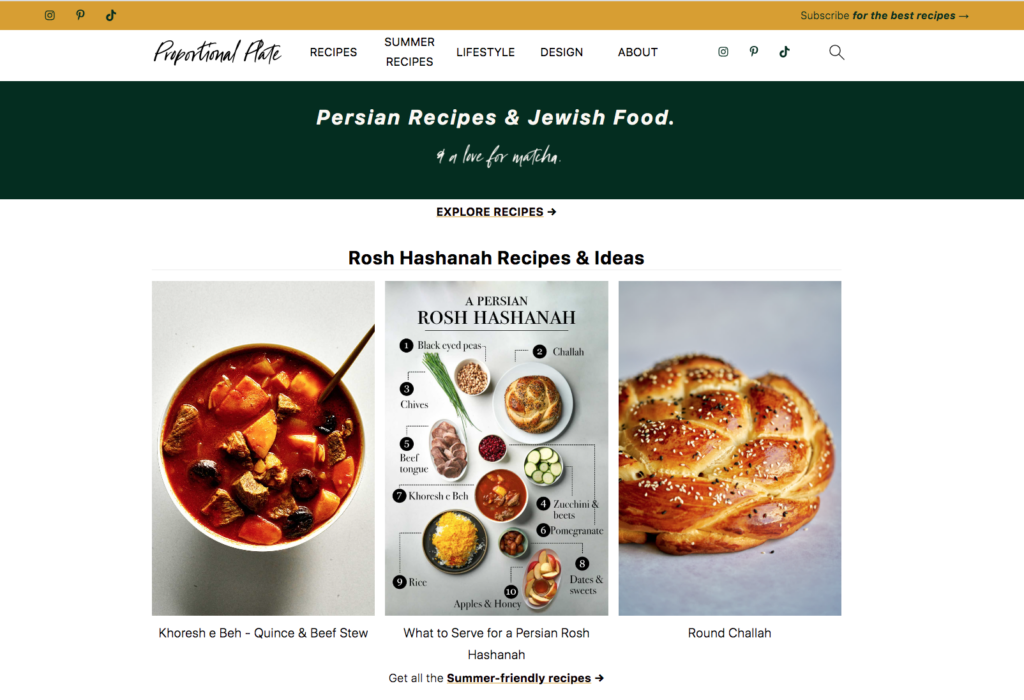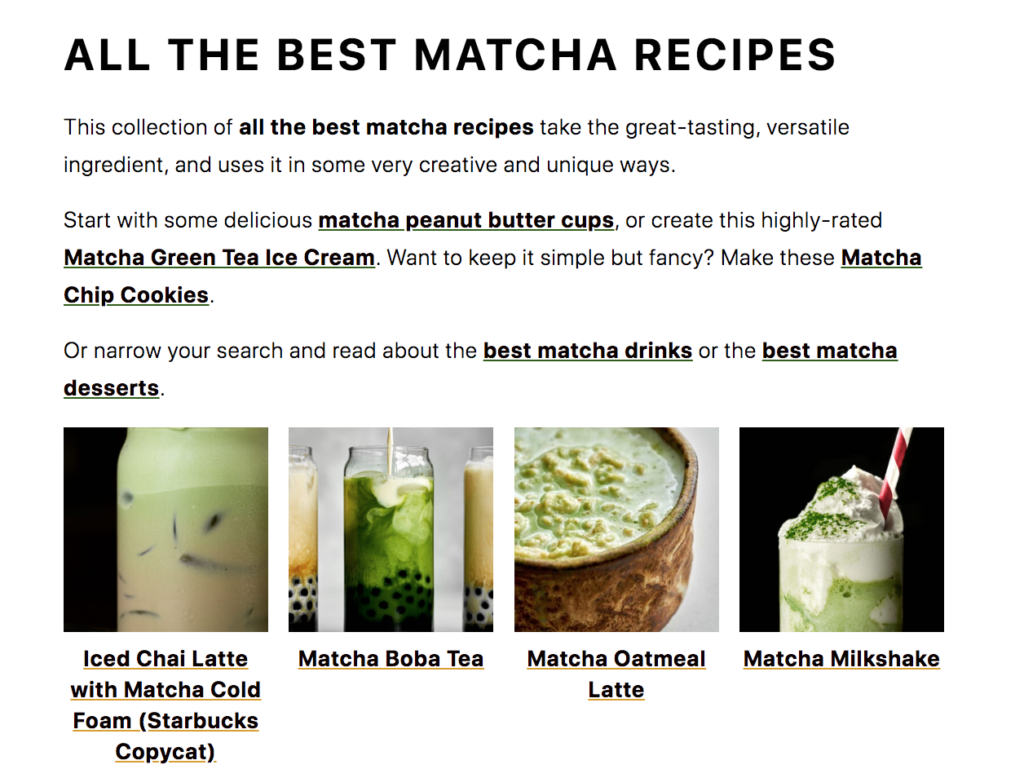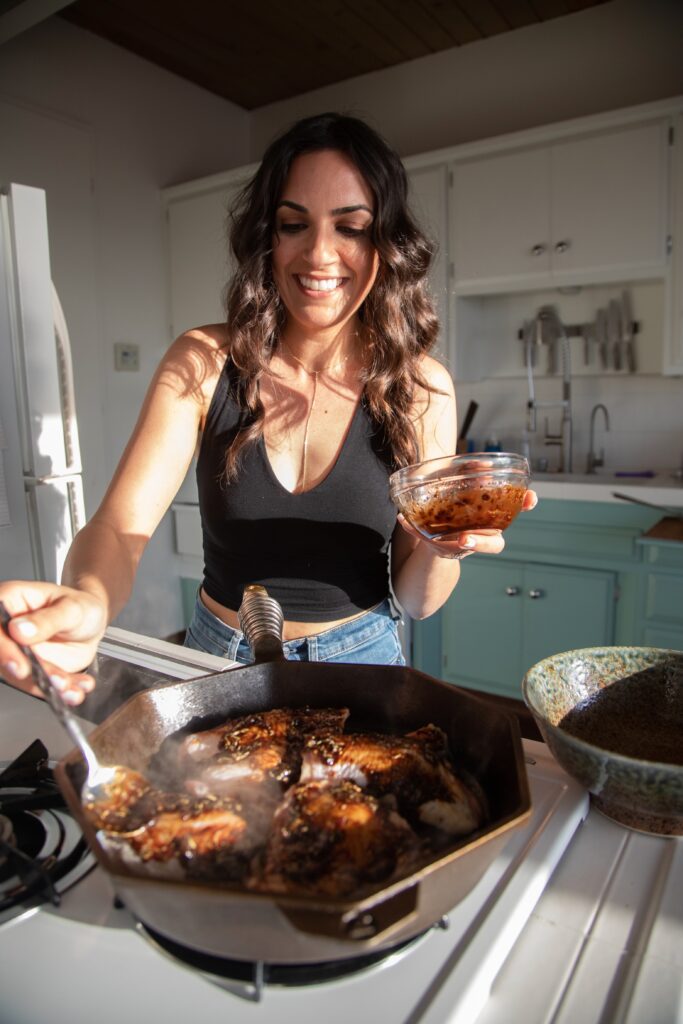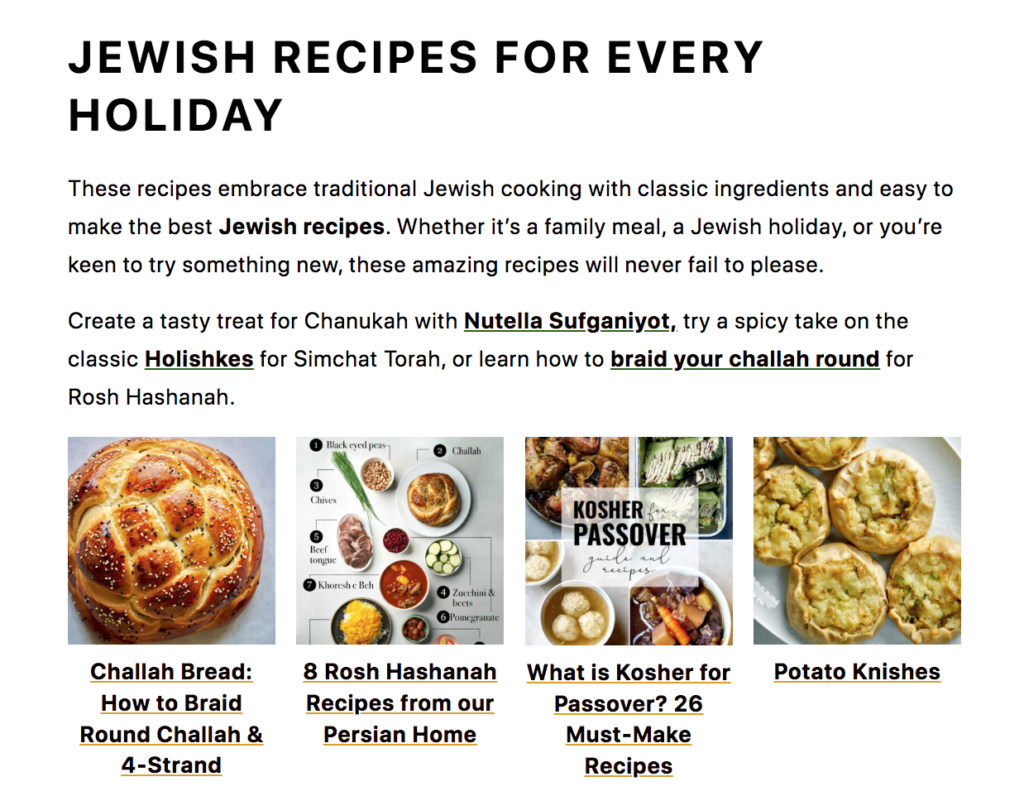How Candice Walker Grew Her Food Blog to $5k/Month With Social Media and SEO

When you buy something through one of the links on our site, we may earn an affiliate commission.
For Candice Walker, running a successful food blog was not on her radar. She was focused on getting multiple master’s degrees and on her job at an engineering firm.
But since she loved to cook, she started sharing her recipes and weekly meal plans online to help her friends. When her website and her social media channels started to gain traction, she started to approach her blog more like a business.
Today, her blog Proportional Plate, which is focused on Jewish, Persian, and matcha recipes, brings in $5k per month.
Keep reading to find out:
- What her background is
- Why she created her blog
- Where her income comes from
- What trend she went viral for
- Her thoughts on branding
- Her approach to SEO
- How she does keyword research
- How she builds links
- Her content creation process
- How long it takes her to perfect a recipe
- How she grows her email list
- Her favorite tools and resources
- Her biggest challenge
- Her greatest accomplishment
- Her main mistake
- The advice she offers other entrepreneurs
Contents
- Meet Candice Walker
- Why She Created Her Website
- How Much Money She’s Making
- Candice’s Blog Traffic
- Her Top Marketing Strategy
- Her Thoughts on SEO
- Her Content Creation Process
- Her Email List
- Her Top Resources
- Her Top 3 Tools
- Her Biggest Challenge
- Her Greatest Accomplishment
- What She Wishes She Knew When She Started
- Candice’s Main Mistake
- Her Advice for Other Entrepreneurs
Meet Candice Walker
Hi there! I’m Candice. I’m a recipe developer and content creator for my food blog Proportional Plate. Cooking and creating recipes is only one of my great passions; another love of mine is mathematics.
I got my bachelor's degree in mathematics at UC Berkeley, then my first master's in mathematics education, and finally my second master's in mechanical engineering. I'm currently the general manager for an engineering firm.
I'm based in Portland, Oregon, and before that, I called Hermosa Beach, LA home. I grew up in California not far from LA and am part of a large Iranian-Jewish family. It was my mother and grandmother's skill in cooking Persian cuisine that nurtured such a passion for Persian dishes in me!
I've always had a great love for travel, and a few years back my husband and I quit our jobs and traveled the world together. I've been lucky enough to live in many different countries and experience the culture of so many different communities, and that’s why a lot of my recipes have global influences.
In addition to my work and business, I'm also a qualified yoga instructor, though I don't teach so much anymore.
Why She Created Her Website
The funny thing about Proportional Plate is that I didn't set out to create a business. I've always loved cooking and creating recipes, and I'm a diligent meal planner.
Friends noticed that I was organized when it came to planning my grocery list and meals for the week, so they asked if I could share my meal plans and recipes with them. I started to create online recipe pages with photos of the finished dish and slowly began to grow my roster of recipes.
I also used to publish a meal plan with a full grocery list for people to use so they could easily plan out the week. It began as a way to easily share with friends and family, and it quickly evolved into a blogging business.
I started to gain traction online and in my social media channels, so I switched gears and started to approach the blog more like a business. I grew primarily through my email subscribers, my social media following on Instagram and Facebook, and Google traffic to my website.
In the beginning, I used Wix.com. At that time, I only shared the recipe cards with no accompanying blog post. I wasn’t looking to get ad revenue.
When I did start to get traffic, that motivated me to make a switch to a more viable web platform, WordPress, to grow and scale my blog.
I started Proportional Plate in December 2016, so I’m coming up on my 7-year anniversary of the business. I think the fact that sharing recipes with friends created this accidental business is quite unique.

I truly didn't set out with the intention of creating a business, but I had something valuable that people wanted to see more of.
How Much Money She’s Making
My blog has many different income streams and my total income differs from year to year. I earn money through brand partnerships, affiliate partnerships, and advertising on my website as well as income from YouTube ads and social media pay-per-view.
In my best years, my income has been between $55,000 and $60,000 per year. Due to the volatility of web traffic, how much sponsored content I’m producing, and even the pandemic’s influence, the range is more accurately $30,000-$60,000.
My income breakdown is as follows:
- Partnerships - 15-35%
- Ads - 60-80%
- Affiliate - 5%
As for how much I work on my site, this is going to seem like a wide estimate but it's the truth. It ranges anywhere from five hours a week to 40 hours a week. It depends so much on my workload, for example, if I have any brand sponsorships or partnerships that require a photo shoot or video production that week, or even if I have a business trip.
Candice’s Blog Traffic
Food blogs are a unique beast when it comes to traffic. It's highly competitive and your traffic is subject to the whim of trends. Because of this, web traffic varies greatly and it's also highly seasonal.
For example, the best-performing time for most food bloggers is the fall/Thanksgiving/Christmas season. Then they’ll typically see a drop off in January and February.
I get about one million annual sessions, but this varies significantly depending on the content I’m producing. In April 2020, when the trend for Dalgona coffee was going viral, I was the first person to hop on the trend of Dalgona Matcha.
That post gained a massive amount of traffic and I have since been ranked number one for the search term. This example brings me to the volatility of keyword ranking. I'm gaining and losing keyword rankings regularly depending on what’s trending and what’s in season, which affects my traffic.

Her Top Marketing Strategy
Defining my brand clearly has been a game-changer. It's only in the last 3 to 4 years that I have been actively dedicated to this task. I took steps to analyze my brand, define what it is that I uniquely offer, and who it is that I'm trying to attract.
Then, I committed to that vision. I’m an extremely experienced home cook with unique expertise in Persian cuisine, Jewish cuisine, and cooking with matcha. Now, everywhere I have a presence, I am consciously showcasing my unique expertise in my brand niche, and I'm communicating that in a clear and transparent way to my readers.
Everyone likes to talk about branding and how important it is, but it's not that complicated. Every consumer wants to be able to quickly understand this: Who are you and what can you offer me?
I have to be able to answer that question quickly so that people understand my brand. This is an ongoing project, and I'm working to get better at it every day.
My three niches were always present but they were not explicitly focused on or made prominent from day one. As with any business I've gone through many seasons with my blog but now with my niche clearly defined the train is going full steam!
Her Thoughts on SEO
SEO is arguably the most important aspect of my business, as my success hinges on my discoverability in Google Search. SEO in the food blogging space is highly competitive, and the difficulty of gaining different search terms is all over the map.
My primary strategy is to rank highly for search terms within my brand niche. That means I want to rank highly for Persian recipes, Jewish recipes, and Matcha recipes.

Every recipe that I create is analyzed with SEO best practices in mind as well as the specific search terms that people are using to find those recipes to give me the best chance possible.
In the beginning, I didn't know anything about SEO nor did I pay too much attention to it. I had started spending time with other food bloggers and I listened to them share details about their ad revenue, which encouraged me to start researching it.
At first, I was only using Google guidelines and what I could find myself online. Fortunately for me, I have a great friend named Justin (creator of Salt Pepper Skillet) who encouraged me to do more research and learn more about it. Now we help each other out when it comes to SEO and other kinds of blog support.
My top tools are SEOquake, Keywords Everywhere, SEMRush, Ahrefs, and Google Search Console.
Keyword Research
When it comes to keyword research, I don't want to chase trends and try to keep up with the content mill. I want to rank highly for keywords relevant to my brand niche.
That means that I do a great deal of competitor research to see which keywords similar bloggers in my niche are ranking for, and then I can either create new content that aims to capture that keyword or I can refresh content I already have to be better optimized for that keyword.
A great deal of keyword research is asking questions. If one keyword is too competitive, is there a similar keyword I can target that would be easier to rank for?
If I have an incredible recipe with great content, why is it not ranking for the main keyword? How can I improve it?
If a competitor is ranking number one for a keyword and I am ranking number two, what are they doing differently or better than me? Then you can make a plan of attack.
I use the tools I mentioned before as well as Google search for keywords, and I pay attention to the FAQs in Google for FAQ writing inspiration.
Link Building
Link building is so important for food bloggers, but it's not the case that any link will do. You need high-quality links from high-ranking domains, but these are hard to get and can be expensive to acquire.
It's very much a pay-to-play space, even if you have outstanding content. I try to get links from entities with high domain authority by reaching out to publications to pitch recipes or posts, or by responding to reporter inquiries.

Cold outreach and HARO are my two primary methods.
The unfortunate problem is that most link building is lazy, and a few mistakes can result in a lot of low-quality links that actually hurt your rankings and search.
Getting good links requires a lot of effort, and I do struggle with that because it often requires a dedicated team or an agency to seek out links and I don't currently have those resources.
Her Content Creation Process
My creation process is all about establishing myself as a primary authority in my brand niche.
That means that for my three pillars of content (Persian, Jewish, Matcha), I want to have the most robust roster of recipes that are all well-researched, well-presented, and informative for the reader. I do a great deal of keyword research to discover and actively fill gaps in my content.
A huge part of my creation process is recipe testing. I recipe test more than the average creator. It’s vital for me to create trustworthy recipes that work reliably for people at a variety of skill levels.

I want my readers to have a great first experience with the recipe so that they come back and make it time and time again. So, for a dairy-free chocolate pudding recipe, I'm testing it with a variety of ingredient ratios, with all varieties of sugars subbed in, and all versions of non-dairy milk that someone could use to give me recommendations.
I currently have 350 articles on my blog. The turnaround time on my recipes varies greatly, Like everything else in my business. My shortest recipe turnaround was under two weeks, but that was a rush job.
For some recipes, it has taken me years to fully test the recipe and complete it to a level that did the recipe justice. For example, baked items like bread usually take a lot longer as I need to experiment with different ratios of ingredients, cook times, preparation methods, etc.
I publish at least weekly but sometimes more often than that if things get in a good flow!
One unique thing about my business worth sharing is that I actively try to partner with local food commissions and food boards here in Oregon.
I believe that it's crucial to support your community, and in my work, there are great opportunities for me to showcase the amazing produce and products made right here in Oregon in my content.
Her Email List
My email list was a really effective way to grow my audience in the earlier days of my blog. It's been difficult to grow my subscribers since email pop-ups were deemed a factor in the poor website experience.
I used to get a steady stream of subscribers through my pop-ups. Then, I had to pivot and try new ways to get subscribers, for example, I've experimented with different themed opt-ins to appeal to different user needs, both outside of and within my brand niche.
I've experimented with the placement of the opt-in box on my website and I'm currently using opt-in forms that illuminate as the user scrolls past them.
I have about 2,000 people on my list at the moment. I should note that I regularly delete inactive subscribers because I don’t want to pay the fee for additional subscribers who aren't engaged with my content.
It's another place where I have to consider the ROI. If I'm paying money for them to have a spot on my email list, I need to consider if it's worth it for me to keep them there if they're not engaging with my content.
Her Top Resources
I think what you find inspiring as an individual is very personal. What works to get someone else pumped up might not work for you.
I would say that any content that connects you to your passion and the things that excite you is worthwhile because it’s a tough business to be a successful blogger or online creator.
It's all too easy to lose sight of the parts that are fun that made you get into it in the first place. Something super niche to me that I love is the "Modern Persian Podcast," as they have fantastic episodes about Persian cuisine and always make me excited to get back to cooking.

For actual technical advice on creating a blogging business, there is such a wealth of free resources out there. I've used the free content produced by HubSpot and Google to grow my skills, as well as learned how to write HTML and CSS code from W3 Schools and similar resources.
Her Top 3 Tools
SEO and keyword research tools like Ahrefs, SEMRush, and SEOquake are some of my most used tools.
It sounds simple, but Excel spreadsheets are essential to help me run data analytics for everything from my financials to social media engagement.
Finally, the suite of tools available via Google including Google Analytics and Google Search Central are so important for running a successful blog.
Her Biggest Challenge
TikTok came in and revolutionized how people discover recipes. It’s becoming a competitive search engine in its own right. I would even say that TikTok has evolved into the go-to platform for people seeking out things like easy weeknight dinners or date night recipes.
On one hand, it’s an excellent platform to showcase your brand and attract new audiences; on the other, it subjects you to the unpredictability of search algorithms and trends.
Most of my income stream still comes from ad revenue through site traffic, but I’ve now had to adapt my business to face competition from other successful online blogs and successful TikTok channels.
Her Greatest Accomplishment
I think an accomplishment I am proud of has been the degree to which I taught myself the skills I needed to make the blog work, everything from how to pitch to brands to photography, editing, and video production.
I’ve honed my skills in these areas over the years and shored up my knowledge in all the aspects of the business that I would need to scale it. It is not easy to turn a blogging business into a revenue stream.
I am proud that I have found a way to do this and still retain my love and passion for my work.
What She Wishes She Knew When She Started
I wish I had known how competitive this world of blogging is and understood that there would be immense pressure to constantly create new content. That content mill is not always sustainable at the level you want it to be, especially if you are working on your business part-time, or alone without any help.
It’s important to remember that most people who are putting out massive amounts of content have entire teams who help them do that. Some successful bloggers have teams of 7+ people to help them produce work at the level they need. It's hard to compare yourself as an individual blogger to that kind of business.
I’ve had to learn how to balance joy, a successful business, and getting help when you need it. I’ve also had to discover the direction I want this business to go, and stay confident about living in that decision and/or adapting as my mind changes.
Candice’s Main Mistake
Expecting myself to do everything well is my biggest mistake. It’s just not possible. I’m proud of the skills I’ve acquired and honed, but there are some things that I can’t do as well, and that’s okay. Being accepting of that has really helped me, and I wish I had that mindset earlier on in my journey.
I'm lucky to always have the help and advice of my fellow food blogger community. I also have a virtual assistant who helps me with my cold outreach, general blog support, and especially helping to write my blog articles.
We concept ideas for new recipes or new article posts together – it’s great to have a creative sounding board!
Her Advice for Other Entrepreneurs
Get help early for the parts you’re not as excited about, so you can focus on what you love as much as possible.
The key is to find someone who is good at the things that you’re not and outsource the parts you struggle with, once you have the resources to do so.
I’m not fully there yet, but the more I get help, the more I love my business and can dedicate myself to the aspects that make me the most happy.
Want to learn step-by-step how I built my Niche Site Empire up to a full-time income?
Yes! I Love to Learn
Learn How I Built My Niche Site Empire to a Full-time Income
- How to Pick the Right Keywords at the START, and avoid the losers
- How to Scale and Outsource 90% of the Work, Allowing Your Empire to GROW Without You
- How to Build a Site That Gets REAL TRAFFIC FROM GOOGLE (every. single. day.)
- Subscribe to the Niche Pursuits Newsletter delivered with value 3X per week
My top recommendations
















